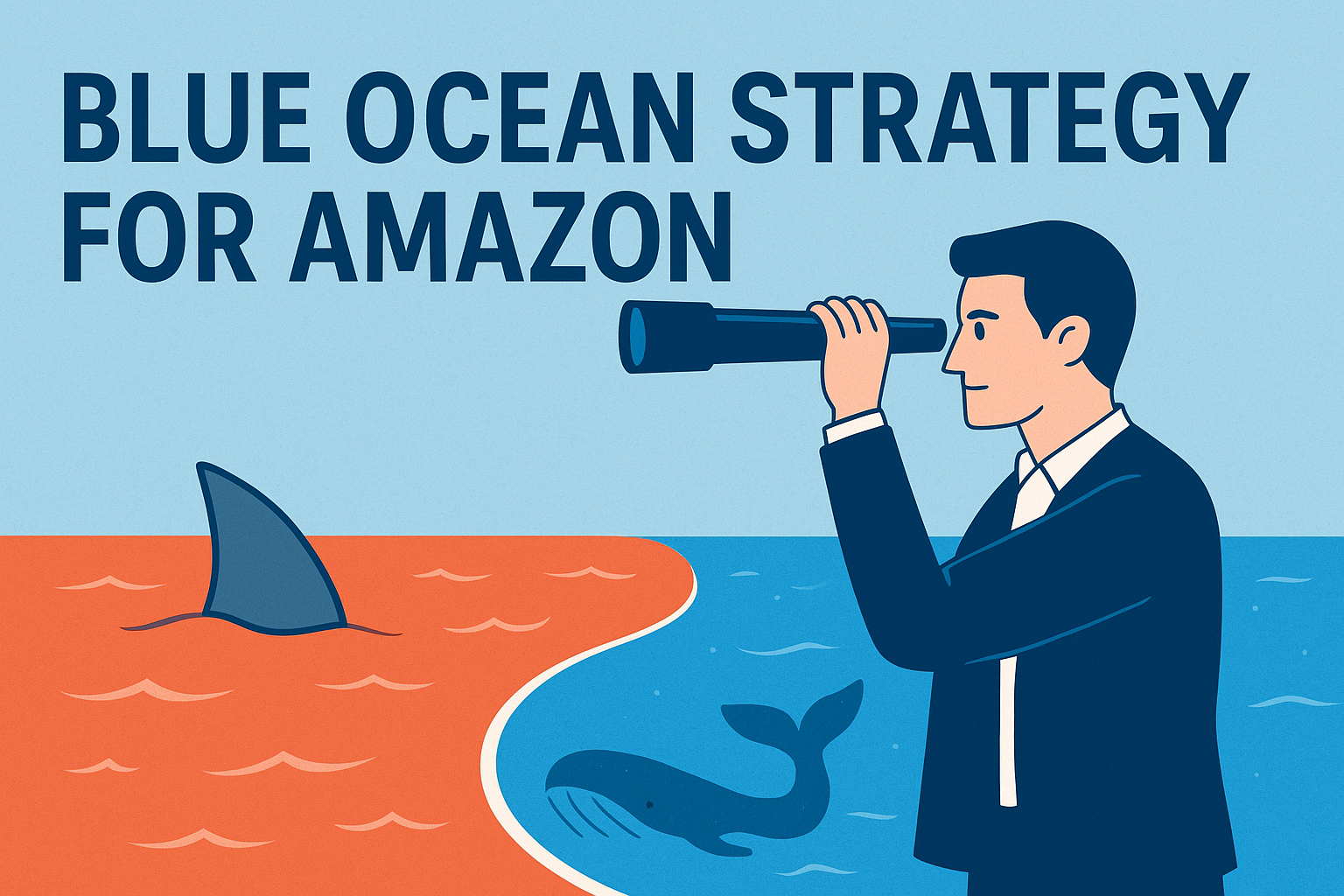Address
304 North Cardinal St.
Dorchester Center, MA 02124
Work Hours
Monday to Friday: 7AM - 7PM
Weekend: 10AM - 5PM

In today’s Amazon marketplace, standing out is harder than ever. Sellers are trapped in red oceans — saturated markets where brands fight over shrinking margins, engage in price wars, and compete for limited visibility.
But there’s another path: the blue ocean market — a space of untapped demand, low competition, and high growth potential. For U.S.-based Amazon sellers, blue oceans are not just a strategy — they’re a lifeline to sustainable success.
A blue ocean market is a niche or category with little or no competition, where demand is unmet or emerging. The concept, coined by W. Chan Kim and Renée Mauborgne in Blue Ocean Strategy, contrasts with “red oceans,” where sellers endlessly fight over existing demand.
In blue oceans, brands don’t compete — they create. They design new products, innovate features, and solve problems others overlook. On Amazon, that means escaping the race to the bottom on pricing and building loyal customers who value innovation and differentiation.
| Challenge (Red Ocean) | Solution (Blue Ocean) |
|---|---|
| Price wars and ad fatigue | Differentiation through innovation |
| High PPC costs | Organic visibility in low-competition niches |
| Shrinking profit margins | Value-based pricing and premium positioning |
| Oversaturated categories | Underserved or emerging niches |
Key benefits of targeting blue oceans:
Look for categories where customer demand exceeds available solutions.
Example: During the pandemic, “compact home workout gear” surged in searches, but few products addressed small-space living — a perfect blue ocean opportunity.
How to find it:
Use tools like Helium 10, Jungle Scout, or DataHawk to analyze keywords with:
Low competition doesn’t mean “no competition” — it means targeting a specific audience ignored by big brands.
Example: Instead of selling “yoga mats,” sell “biodegradable yoga mats for travelers.”
Signals of low competition on Amazon:
In blue oceans, you set the price based on unique benefits. For example, a luxury dog bed for anxious pets commands premium pricing because it solves a pain point generic products ignore.
Margin-boosting tactics:
A healthy blue ocean evolves. Once you dominate a niche, expand laterally into related products.
Example: Start with “organic baby food for sensitive stomachs”, then expand into “hypoallergenic baby wipes” or “BPA-free feeding bottles.”
Leverage Amazon FBA and AWD (Amazon Warehousing & Distribution) to scale without the logistics headache.
Dive into reviews and Q&A sections. Look for repeated complaints like “too noisy,” “hard to clean,” or “breaks easily.”
➡ Example: Complaints about “loud blenders” led to the rise of quiet blenders for small kitchens — a successful blue ocean segment.
Target groups often overlooked: seniors, digital nomads, eco-shoppers, or remote workers.
Search “best [product] for seniors” — if few listings exist, that’s a potential blue ocean.
You don’t need to invent — you can improve.
Use the Four Actions Framework:
Example: A phone case with UV sanitizing lights turned a commodity into a premium innovation.
Check Amazon Keyword Tool, Google Trends, or Helium 10 Magnet for search volume and competition.
A keyword like “silent portable air conditioner” with 5,000+ monthly searches but limited listings = strong blue ocean signal.
A small U.S. brand, EcoBake, spotted a market gap: customers wanted reusable baking mats that were both BPA-freeand dishwasher-safe.
Competitors offered one or the other.
EcoBake combined both benefits and launched its product under a targeted keyword: “dishwasher-safe silicone baking mat.”
Results in 6 months:
This demonstrates how identifying a simple market imbalance can turn a red ocean into your personal blue ocean.
| Mistake | Impact | Fix |
|---|---|---|
| Expanding too fast | Diluted focus | Perfect one niche first |
| Ignoring feedback | Lost innovation edge | Continuously monitor reviews |
| Skipping education marketing | Slow sales | Teach customers why your product matters |
| No defensibility | Rapid imitation | Use branding, design patents, or sourcing barriers |
The U.S. ecommerce landscape is crowded, but opportunities remain for sellers who think differently.
Our team helps Amazon sellers identify, validate, and dominate blue ocean niches using real-time data and proven growth frameworks.
👉 Contact us for a free consultation to learn how to reduce competition, raise margins, and future-proof your Amazon business.
Q1. How is a blue ocean different from a niche market?
A niche market is a subset of an existing market. A blue ocean is a new or underserved space with little to no competition.
Q2. Can any Amazon seller enter a blue ocean?
Yes — smaller sellers often move faster than big brands and can pivot to capture emerging demand.
Q3. How long does a blue ocean stay “blue”?
It depends on innovation. Protect your niche with brand equity, intellectual property, and continuous product improvement.
Amazon blue ocean strategy, low-competition Amazon niches, how to find profitable products on Amazon, Amazon product differentiation, blue ocean eCommerce, Amazon FBA niche research, Helium 10 niche analysis, Amazon innovation strategy.